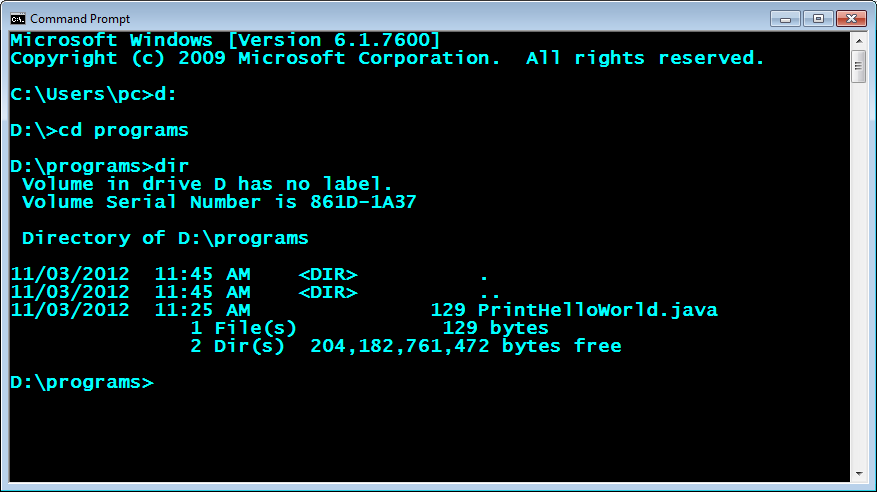

- #Compiling java in terminal subclass mod
- #Compiling java in terminal subclass manual
- #Compiling java in terminal subclass code
Java java_cup.Main = '0' & next_char <= '9')

(on a Unix system at least) we might invoke CUP using a command like: If this specification were stored in a file parser.cup, then To produce a parser from this specification we use the CUP generator. Part of the specification contains the grammar. The third part specifies the precedence andĪssociativity of terminals. Terminals and non-terminals hold no value. If no type is specified, the terminal or non-terminalĬarries no value. Terminal or non-terminal is the type of the value of those terminals or In this case, the terminalsĪre declared as either with no type, or of type The second part of the specification declares terminals and non-terminals,Īnd associates object classes with each.
#Compiling java in terminal subclass code
In this case we indicate that the java_cup.runtimeĬlasses should be imported, then supply a small bit of initialization code,Īnd some code for invoking the scanner to retrieve the next input token. To specify how the parser is to be generated, and supply parts of the The first part provides preliminary and miscellaneous declarations However, here we can quickly see that the specification contains four We will consider each part of the specification syntax in detail later.
#Compiling java in terminal subclass mod
Terminal SEMI, PLUS, MINUS, TIMES, DIVIDE, MOD * Terminals (tokens returned by the scanner). * Preliminaries to set up and use the scanner. CUP specification for a simple expression evaluator (no actions) Grammar can be used, after specifying precedences and associativities.īased on these namings we can construct a small CUP specification Now there is a construct allowing the user to specify precedences andĪssociativities for terminals. Older versions of CUP forced the user to write unambiguous grammars, but Seven by six, or it can evaluate 4 * 6 and then add three. The grammar can either evaluate the 3 + 4 and then multiply Input, can reduce the parts of the input in two different ways such as An ambiguous grammar is a grammar which, given a certain The experienced user will note a problem with the above grammar. SEMI, PLUS, MINUS, TIMES, DIVIDE, MOD, NUMBER, LPAREN, Name the set of terminal symbols that will appear on input, and the set of To specify a parser based on this grammar, our first step is to identify and With a semicolon), evaluate them, and print the result on standard output.Ī grammar for the input to such a system might look like:Įxpr_list ::= expr_list expr_part | expr_partĮxpr ::= expr '+' expr | expr '-' expr | expr '*' expr This system would read expressions from standard input (each terminated System for evaluating simple arithmetic expressions over integers. Scanner capable of breaking characters up into meaningful tokens (suchĪs keywords, numbers, and special symbols). Grammar for which a parser is needed, along with construction of a Using CUP involves creating a simple specification based on the Understanding how CUP specifications work.Ī number of compiler construction textbooks (such asĪnd discuss the YACC system (which is quite similar to this one) as a A working knowledge of YACC is also very helpful in
#Compiling java in terminal subclass manual
Java code, and produces parsers which are implemented in Java.Īlthough this manual covers all aspects of the CUP system, it is relativelyīrief, and assumes you have at least a little bit of knowledge of LR However, CUP is written in Java, uses specifications including embedded and in fact offers most of the features of YACC.

It serves the same role as the widely used program YACC This manual describes the basic operation and use of theīased Constructor of Useful Parsers (CUP for short).ĬUP is a system for generating LALR parsers from simple specifications. However, gives the user more power and options, making parser specifications Manual will be necessary to write new specifications. Not compatible and a reading of appendix C of the new As a result, the old 0.9 parser specifications for CUP are

These changes attempt to make CUP more like its About CUP Version 0.10 VersionĠ.10 of CUP adds many new changes and features over the previous releases Incompatibilites between CUP 0.9 and CUP 0.10 D. Graphics Visualization and Usability Center


 0 kommentar(er)
0 kommentar(er)
